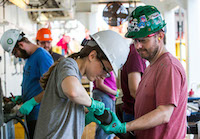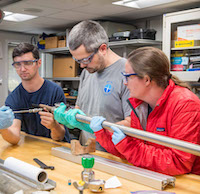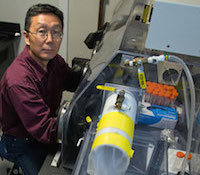Scientific drillships allow scientists access to some of Earth's most challenging environments, collecting data and samples of sediment, rock, fluids, and living organisms from below the seafloor. A long running international collaboration in scientific ocean drilling has transformed human understanding of our planet, addressing fundamental questions about Earth's dynamic history, processes, and structure. The growth of scientific ocean drilling as a research technique has led to the development of new tools and methodologies and has fostered enduring international collaborations in research, education, and public engagement.
1940: Advancement in Piston Coring
Advances in piston coring in the 1940s allowed research ships to routinely recover long sediment sections from the seafloor. These ocean bottom sediments, accumulating slowly over geologic time, contain microscopic fossils whose chemistry is a proxy for ancient ocean conditions. Piston coring was used on expeditions such as the worldwide cruise of the Swedish research vessel Albatross to begin studying the rich and varied planetary history captured at the bottom of the world's oceans.
1961: Project MoHole
In 1961 when dynamic positioning was successfully used to keep the drilling platform CUSS I on target in strong current, scientific drilling took root as a feasible technology to study Earth's subseafloor geology. Project Mohole, a concept proposed to the U.S. National Science Foundation, considered the feasibility of drilling through the geological boundary identified by an abrupt change in rock physical parameters (Mohorovičić discontinuity) that marks the transition from thin oceanic crust to the mantle, Earth's main interior layer.
1966-1983: Deep Sea Drilling Project (DSDP)
The next phase of scientific ocean drilling, the Deep Sea Drilling Project (DSDP 1966-1983), began in 1966 using the Drilling Vessel Glomar Challenger. This pioneering vessel conducted drilling and coring operations in the Atlantic, Pacific, and Indian Oceans as well as the Mediterranean and Red Seas. The Glomar Challenger also advanced the technology of deep-ocean drilling.
1983-2003: Ocean Drilling Program (ODP)
In 1985, the JOIDES Resolution replaced the Glomar Challenger at the start of the Ocean Drilling Program (ODP 1983-2003). ODP was truly an international cooperative effort to explore and study the composition and structure of the Earth's subseafloors. The JOIDES Resolution conducted 110 expeditions for ODP at 2000 drill holes located throughout the world's ocean basins.
2003-2013: Integrated Ocean Drilling Program (IODP)
The Integrated Ocean Drilling Program (IODP 2003-2013) built upon the international partnerships and scientific success of the DSDP and ODP by employing multiple drilling platforms financed by the contributions from 26 participating nations. These platforms - a refurbished JOIDES Resolution, the new marine-riser equipped Japanese Deep Sea Drilling Vessel Chikyu, and specialized Mission-Specific-Platforms - were used to reach new areas of the global subsurface during 52 expeditions. The IODP 2003-2013 Legacy Document Archive contains reports, minutes, and other documents from the program's panels and advisory bodies.
2013-2024: International Ocean Discovery Program (IODP)
The IODP partners continued their collaboration via the International Ocean Discovery Program (IODP) between October 2013 and September 2024. Read more about the science, operations, and structure of IODP throughout iodp.org.



